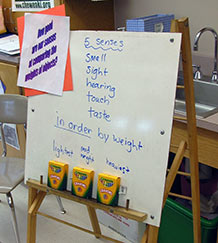How good are our senses at comparing the weights of the cubes?
2. Explore sensed weight

Use the three objects that appear identical but have different weights:
- What if we wanted to order these objects by weight, from most weight to least weight, and all we could use was our sense of sight? Could we do that?
- Could hearing help us? How?
- What about touch?
Listen for student ideas about weight and how a person can tell what something weighs. This can lead to a conversation about guessing, and how estimating differs from guessing.
Language note: Make sure students understand how “order” is used in this lesson, i.e., as a verb meaning “to place things in order according to a rule.” As an illustration, choose three students and ask them to “order themselves” (or “put themselves in order”) by height. Ask other students to order themselves by birthdays, house numbers, and so on until you are confident everyone has a common understanding of the concept.
Next, ask two volunteers to compare the objects’ weights using their hands, and to put them in order by “felt weight.” When the students have finished ordering the boxes, compare the results.
- Can we trust our eyes to compare the weights of objects?
- Can you think of a time when your eyes fooled you, and you were surprised by the feel of something’s weight?
- What about touch?
Explain that all students will have a chance to order objects by weight using just their hands and their sense of “felt weight.”



